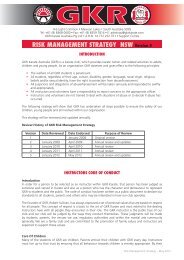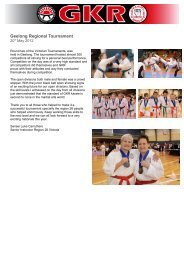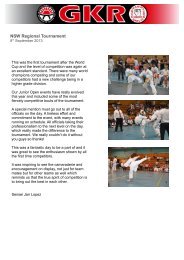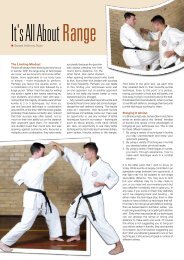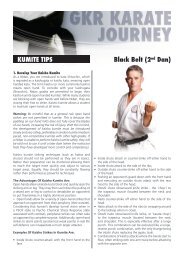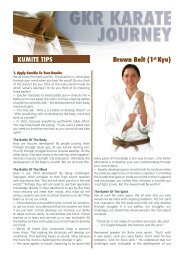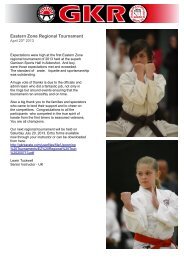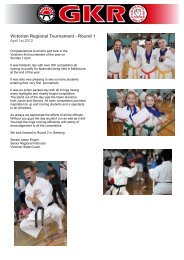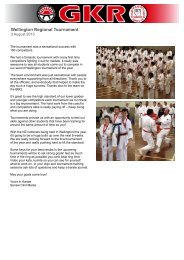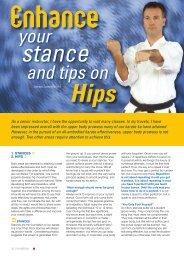Red Belt (4th Kyu) KumiTe TipS - GKR Karate
Red Belt (4th Kyu) KumiTe TipS - GKR Karate
Red Belt (4th Kyu) KumiTe TipS - GKR Karate
You also want an ePaper? Increase the reach of your titles
YUMPU automatically turns print PDFs into web optimized ePapers that Google loves.
c) Turning the defender on their axis. In Bassai-dai, we<br />
don’t just execute blocks. We block with one arm, and<br />
with our second arm, execute a follow up block (ren<br />
uke) in the attempt to either control our opponent or to<br />
turn them on their axis (exposing their sides or back).<br />
» Other examples of how Bassai-dai can be implemented<br />
in sparring are explode forwards in straight line<br />
movements, getting to the outside of an attacker by<br />
stepping the front foot past the opponent’s front foot<br />
etc.<br />
» There are also techniques such as sweeps and<br />
takedowns. But these are not yet permitted at <strong>Red</strong><br />
belt.<br />
6. Develop Your Own Senjutsu (Strategy)<br />
How would you describe your sparring style? When<br />
observing a karate-ka spar, you should not see them use<br />
the same style of kumite against every opponent they face.<br />
You should see them adapt their style according to their<br />
opponent.<br />
» There is a Japanese saying that “A light wind is unable<br />
to move an Oak tree. It stands strong and defiant. But the<br />
light wind is able to push the grass around to and fro.<br />
However the strongest of winds are able to uproot the<br />
Oak tree - who tried to stand defiant. Yet the strongest of<br />
winds are unable to uproot grass because it moves to and<br />
fro.” The point is, sometimes we need to be an oak tree<br />
and sometimes we need to be the grass. This is but one<br />
example of why we need to change our style of fighting.<br />
» Up until <strong>Red</strong> belt you have simply been trying to get good<br />
at what you already know while trying to add to this new<br />
techniques and principles. Now that you are starting to get<br />
a hold of these it’s important that you start understanding<br />
when each one can be best used.<br />
» Let’s look at defence as an example. To date we have<br />
discussed creating distance (via retreating or side-stepping),<br />
blocking and countering, anticipating (pick offs) and just<br />
recently, using the principle of Bassai-dai of turning an<br />
opponent on their axis with the use of two blocks (ren<br />
uke). The big question is, when is the best time to use<br />
each one?<br />
» Then there is the question of attacking. For example,<br />
when is the best time to use a side kick? Is there one?<br />
» Having reached a fair level of conscious competence,<br />
it’s time to start thinking about strategy. Gichen Funakoshi<br />
had 20 precepts for training. Of these was, “Tattakai wa<br />
kyo-jitsu no soju ikan ni ari,” which translates roughly<br />
as “Transform yourself according to the opponent.”<br />
Funakoshi also wrote ‘the secret of combat resides in the<br />
art of directing it (strategy).”<br />
Think about each type of opponent you might come up<br />
against. Some examples are:<br />
• Fast people<br />
• Strong people<br />
• Good counter attackers<br />
• Good kickers<br />
• Good strikers<br />
• People who pick off well<br />
• Offensive minded people<br />
• Offensive minded people who generally attack with<br />
multiple attacks<br />
• Offensive minded people who generally attack with<br />
singular and/or double techiques<br />
• People who stand very still<br />
• People who move around a lot<br />
Now think about what techniques or strategies would best<br />
serve you against each type of person.<br />
» The following is an example against an opponent who<br />
has an excellent sen-no-sen (anticipation technique or pick<br />
off):<br />
a) Feint attacking often to upset their rhythm and help<br />
reveal their intentions. Having revealed their intention,<br />
it will cause hesitation in them.<br />
b) Move around a lot. This will prevent them from getting<br />
settled in a poised stance. To pick off, most people want<br />
to feel poised in a stance they can spring out of. If they<br />
are constantly moving to adjust to your movements (eg<br />
circling) they will be unable to do this.<br />
c) Throw the occasional side kick off the front foot into<br />
their lower stomach. If this is done quickly, they will<br />
not be able to get in before you execute it. But it also<br />
diminishes their confidence because most people do not<br />
wish to run in to a side kick.<br />
While there have been many articles (found in the Training<br />
category of the Articles section) that offer many strategies<br />
for kumite, it’s important that you take time to think of<br />
your own.<br />
» This will help you assess your own level of understanding<br />
of techniques and principles.<br />
» It will also teach you to think about strengths and<br />
weaknesses of techniques and strategies.<br />
7. Disturb Your Opponent’s Guard With Your Hands<br />
At Green belt we introduced you to the idea of feinting<br />
with your hands. At Blue belt we introduced you to the<br />
idea of feinting with your legs. One of the strategies behind<br />
feinting was to disrupt your opponent’s thoughts. In short,<br />
it’s hard to strategise when your opponent’s movements<br />
continually disrupt your thoughts.<br />
» Disturbing your opponent is a step above feinting and in<br />
many ways can be considered an advanced version of the<br />
feint. So what does disturbing involve?<br />
» The Start and Stop version of the feint (see the Green<br />
<strong>Belt</strong> section) required a person to quickly step their front<br />
foot out slightly and partly execute a technique before<br />
quickly retreating back to their fighting stance.<br />
» The disturb takes this one step further. The goal is to<br />
actually make contact with your opponent’s guard. While<br />
you can step and reach out and touch your opponent’s<br />
guard with your rear hand, it is advised to develop the skill<br />
using your front hand.<br />
» This was not suggested prior to <strong>Red</strong> belt because it<br />
requires you to get closer to your opponent, and if one



